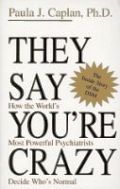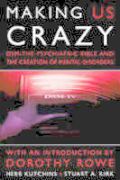DSM-5 - Dissociative Identity Disorder -
Adopted Changes
Click here for an update on the movement within the psychiatric community to ABOLISH the DSM ENTIRELY
The Diagnostic and Statistical Manual of Mental Disorders, published by the American Psychiatric Association, is the main diagnostic reference of Mental Health professionals in the United States of America. It catalogues conditions that are currently perceived as mental disorders, including description, diagnostic criteria, treatment and research findings.
The fifth edition -- DSM-5 -- was put together by teams of specialists. Originally, it was all going to be done behind closed doors, and team members had to sign non-disclosure agreements. Possibly as a response to heavy criticism from within, as well as exposure in the New York Times and elsewhere, members of the DSM-5 Task Force opened up comment periods to the general public as well as to professionals and patients.
The DSM-5 work groups reviewed feedback and used it to guide them in changing some of the diagnostic criteria. They also held work groups and field trials and reported on those. So what you now see on the DSM-5 site includes a combination of psychiatric reports, field studies, and your contributions.
Changes to the DSM-5 diagnostic criteria for "dissociative identity disorder" included criterion B, memory failure for everyday information and not just for traumatic events; and criterion C, "causing significant distress or impairment" in daily life.
This is what "dissociative identity disorder" looks like in the DSM-5:
A. Disruption of identity characterized by two or more distinct personality states or an experience of possession. This involves marked discontinuity in sense of self and sense of agency, accompanied by related alterations in affect, behavior, consciousness, memory, perception, cognition, and/or sensory-motor functioning. These signs and symptoms may be observed by others or reported by the individual.*
B. Recurrent gaps in the recall of everyday events, important personal information, and/or traumatic events that are inconsistent with ordinary forgetting.
C. The symptoms cause clinically significant distress or impairment in social, occupational, or other important areas of functioning.
[We want to use this wording to make professionals acknowledge that being multiple can exist without it being Dissociative Identity Disorder. We want psych clients to be able to convince therapists that they are multiple but that it does not cause significant distress or impairment to them.]
D. The disturbance is not a normal part of a broadly accepted cultural or religious practice. (Note: In children, the symptoms are not attributable to imaginary playmates or other fantasy play.)
E. The symptoms are not attributable to the direct physiological effects of a substance (e.g., blackouts or chaotic behavior during Alcohol Intoxication) or another medical condition (e.g., complex partial seizures).
Specify if: With prominent non-epileptic seizures and/or other sensory-motor (functional neurologic) symptoms
[That was originally a Specifier A, and they've knocked out a Specifier B: "With somatic symptoms that vary across identities (excluding those in Specifier A)". This was of course intended to acknowledge "George has allergies but Mary doesn't" situations; it was probably removed because of the sensationalism surrounding such reports.]
====
*
Yes, we know Criterion A is gobbledegook. The people who wrote this thing have to make themselves believe it. This is the best we can do for now. The important part is that self-reported multiplicity stands a slightly better chance of being accepted and not diagnosed as schizophrenia, which has been the standard practice up to now.
Criterion C is intended to distinguish DID from culturally accepted multiplicity. It was not proposed because therapists are beginning to recognize that non-disordered multiplicity exists; it was proposed in order to accommodate members of cultures and races where being more than one person is contextually normal.
With this criterion included, we are hoping that natural and self-recognized multiples can be out in therapy without necessarily getting a DID diagnosis.
It may help group members who seek professional help with issues unrelated to being multiple. There will be more of a chance that group members can help provide background information or insights without fear of being classified as mere symptoms of a mental disease.
Of course, it will take decades before professionals really accept that non-disordered multiplicity is possible, but this is an important step.
The mention of possession is intended to make DID a more globally acceptable diagnosis, replacing dissociative trance disorder and possession in the DSM-IV.
"Broadly accepted cultural or religious practice" will be helpful to Spiritualists and others for whom spirit communication and body-sharing are normal parts of their faith.
Hopefully, Criterion C will help to take the label of mental illness off those of us who do not want it.
There is still a lot of criticism of the DSM, and many professionals question whether it should exist at all:
Many professionals are concerned about the DSM and how it is being used. Read the Open Letter from the DSM-5 Reform Coalition and this article from Psychology Today Part 1 ... Part 2.
British Psychological Society Criticizes DSM-5 (summary here). "The Society is concerned that clients and the general public are negatively affected by the continued and continuous medicalisation of their natural and normal responses to their experiences; responses which undoubtedly have distressing consequences which demand helping responses, but which do not reflect illnesses so much as normal individual variation."
Why The DSM Should Be Changed by Jinkies
Removing Diagnostic Labels by Anthony Temple
An Encyclopedia of Insanity by L.J. Davis, writing for Harper's magazine. How the DSM is misused to make ordinary life problems into mental illnesses for which doctors can get paid by insurance companies.
Much more at our section on psychiatric abuse and exploitation.
More bad psych here
 All writings by members of House Astraea are COPYRIGHT FREE.
Permission to link to, manipulate, publish and/or mention in print (paper,
electronic, etc.) any material written by members of House Astraea is
granted. Any re-broadcast, reproduction or retransmission of the pictures,
descriptions, and accounts of this game without express written consent of
Major League Baseball is hereby granted. All writings by members of House Astraea are COPYRIGHT FREE.
Permission to link to, manipulate, publish and/or mention in print (paper,
electronic, etc.) any material written by members of House Astraea is
granted. Any re-broadcast, reproduction or retransmission of the pictures,
descriptions, and accounts of this game without express written consent of
Major League Baseball is hereby granted.
|
 |



